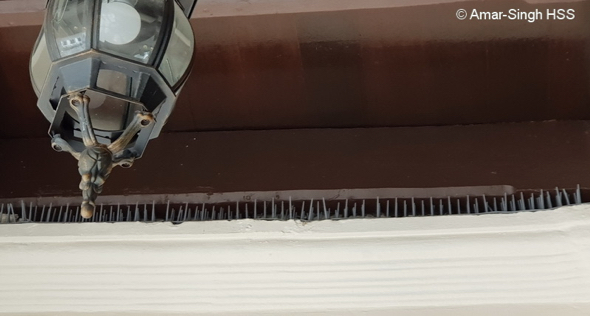“A number of birds have adapted to living in our cities, possibly due to availability of food supply or a shrinking environment. Unfortunately, some segments of the human population are not able to cope with birds nesting or roosting, especially on commercial buildings due to their droppings and perceived risk of disease transmission.
“The Rock Pigeon (Rock Dove, Columba livia), in particular, is the target of interventions to reduce nesting or roosting at commercial buildings. I had previously written about the many mechanisms used to prevent the presence of birds at airports, and some of these ideas also apply to commercial buildings (Amar-Singh HSS 2018).

“My wife and I have been observing this ‘battle’ between Rock Pigeons and commercial building owners in our city. Repeated cleaning of ledges and destruction of nests to frighten off the birds has not worked. To prevent nesting and roosting at ledges on these commercial building in the city, the owners have now put in ‘bird spiking installations’ i.e. upward pointing wires or spikes to prevent landing or nesting (above). These are ‘anti-perching spikes’ and are primarily useful for birds roosting on sills or ledges. Spikes are glued to the surface and may be made of metal or plastic. They are claimed to be not harmful to birds. (Abouzeid et al 2007). A recent local news report claims these are effective (Amalina 2019). However, we have observed that the birds have adapted and are able to nest successfully again (below).

“The spikes have adjusted by placing extra material on top of the spikes until a stable platform has been achieved for nesting. Of concern is how juveniles will cope with moving around once they are ambulatory but not ready to fly. As one building magazine points out, this type of system works well in light-pressure areas, ‘in heavy-infestation situations, birds can roost and build nests in the wires’ (Gellerstedt 2008).
“In some regions (Bristol, UK) some individuals have taken this whole issue too far. They have installed large volumes of bird spikes on branches of trees overhanging a car park, so as to protect the ‘expensive’ cars parked there (Sawer 2017; you have to see the images to see the extent of the work/folly). It appears that humans are more in need of change than birds.”
Dato’ Dr Amar-Singh HSS
Ipoh, Perak, Malaysia
11th February 2019
Location: Ipoh, Perak, Malaysia
Habitat: Urban environment
References:
1.Amar-Singh HSS. 2018. Bird Strike or Bird Aircraft Strike Hazards. Bird Ecology Study Group. Available HERE.
2. Adam Abouzeid, David Channon, Phil Sever. 2007. Bird Damage to Historic Buildings. The Building Conservation Directory. Available HERE.
3. Intan Amalina. 2019. Simple device to deflect birds. The Star Online. Malaysia. Available HERE.
4. Cory Gellerstedt. 2008. Bird Prevention for Your Buildings. Buildings. Stamats Communications, Inc. Available HERE.
5. Patrick Sawer. 2017. Anger as anti-bird spikes used on trees to protect cars in Bristol. The Telegraph.Telegraph Media Group, UK. Available HERE.








